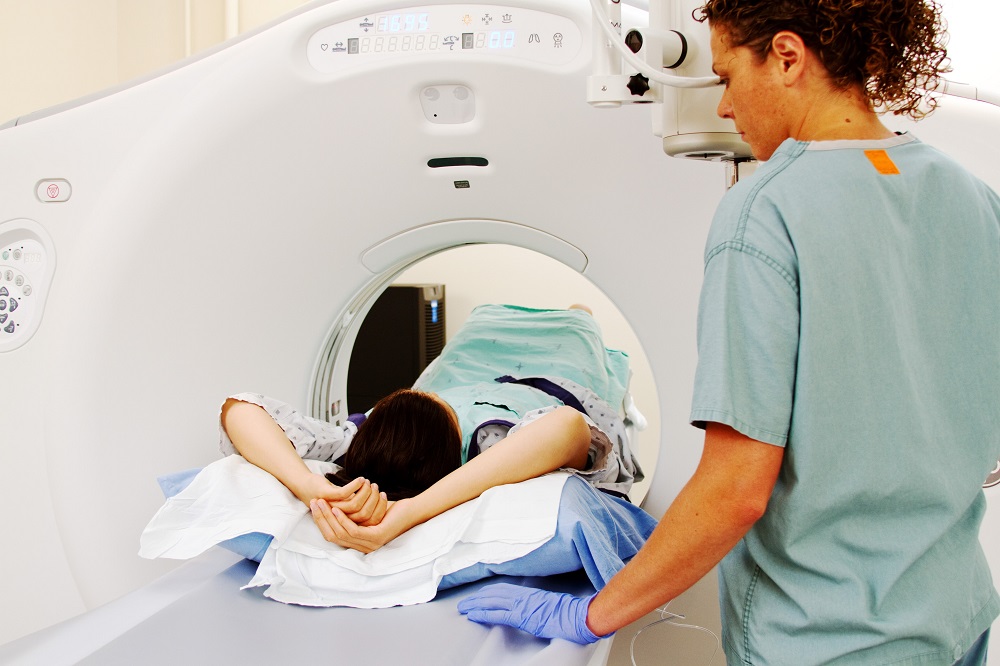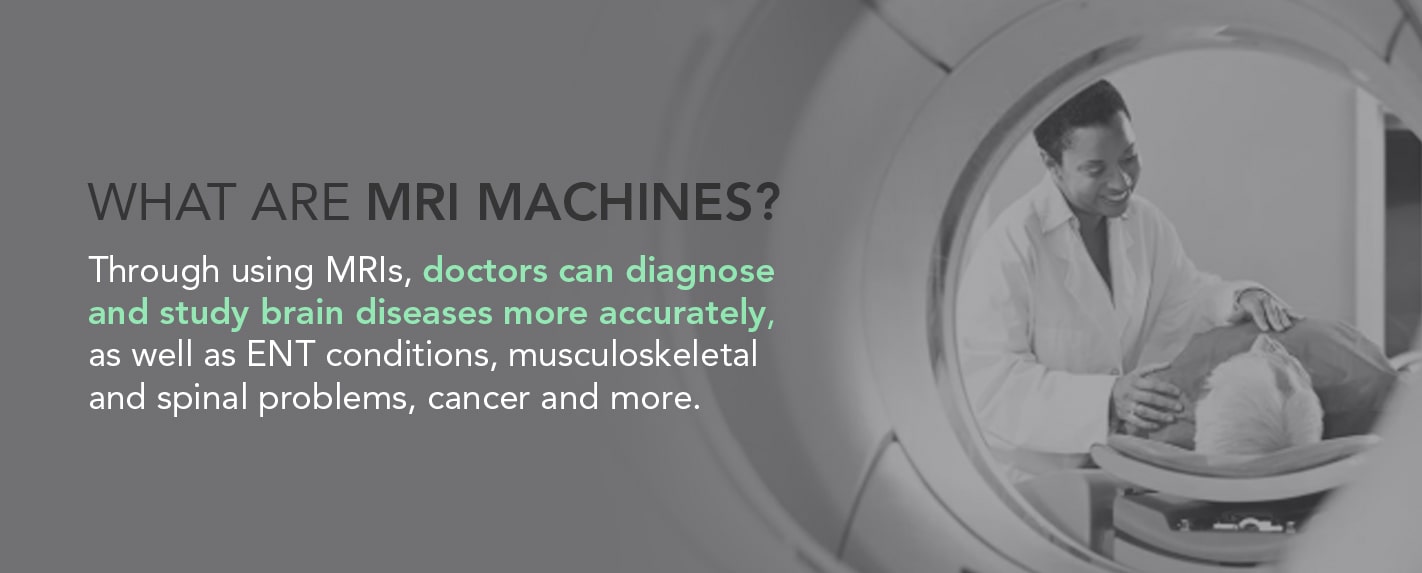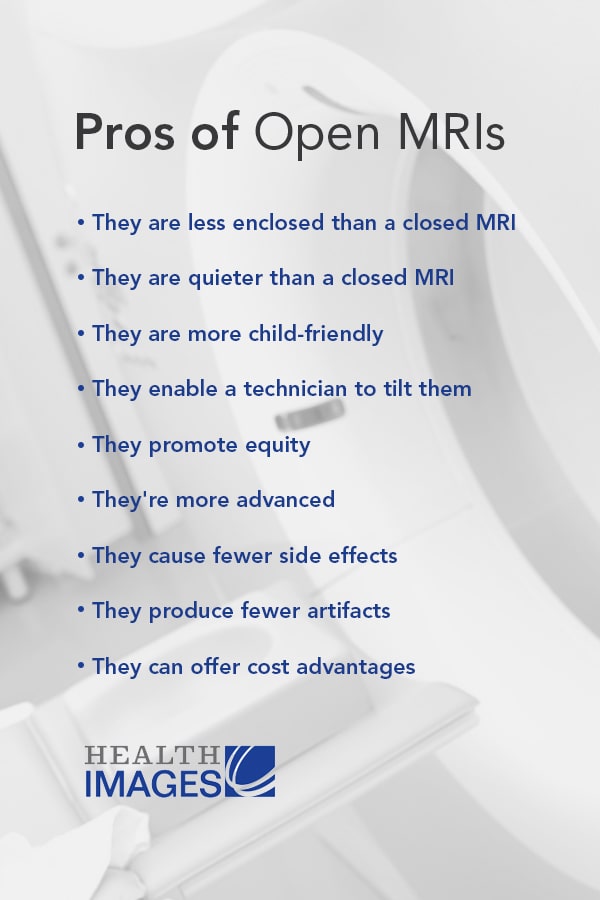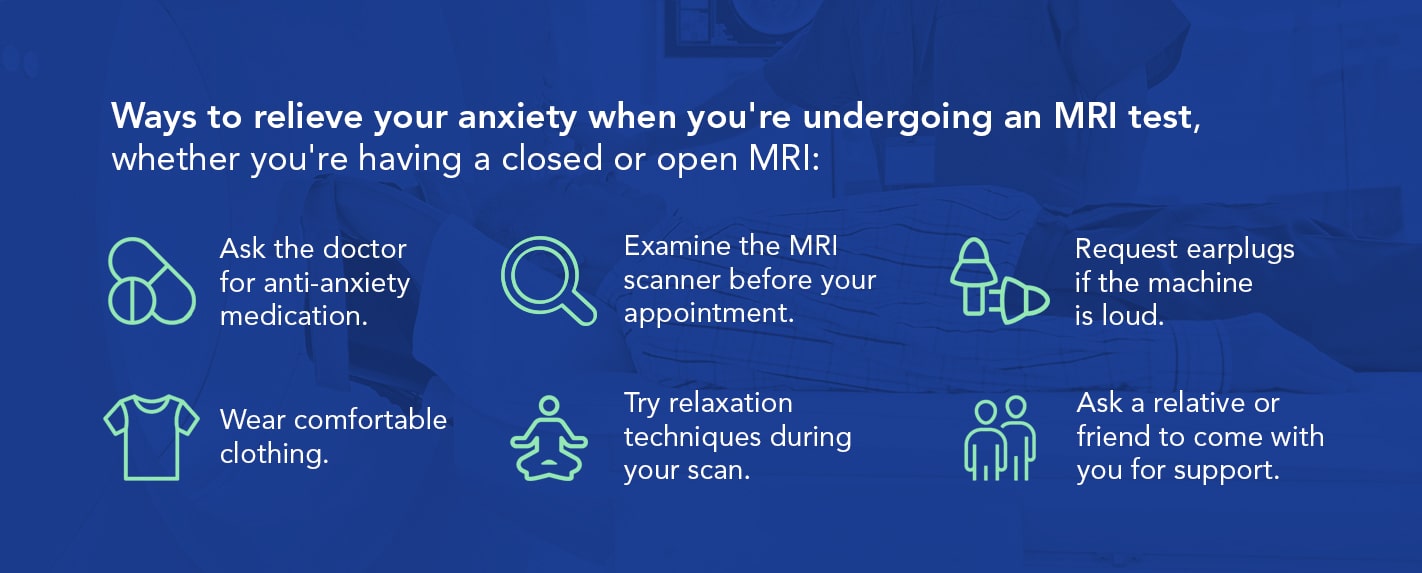Open MRI vs. Closed MRI
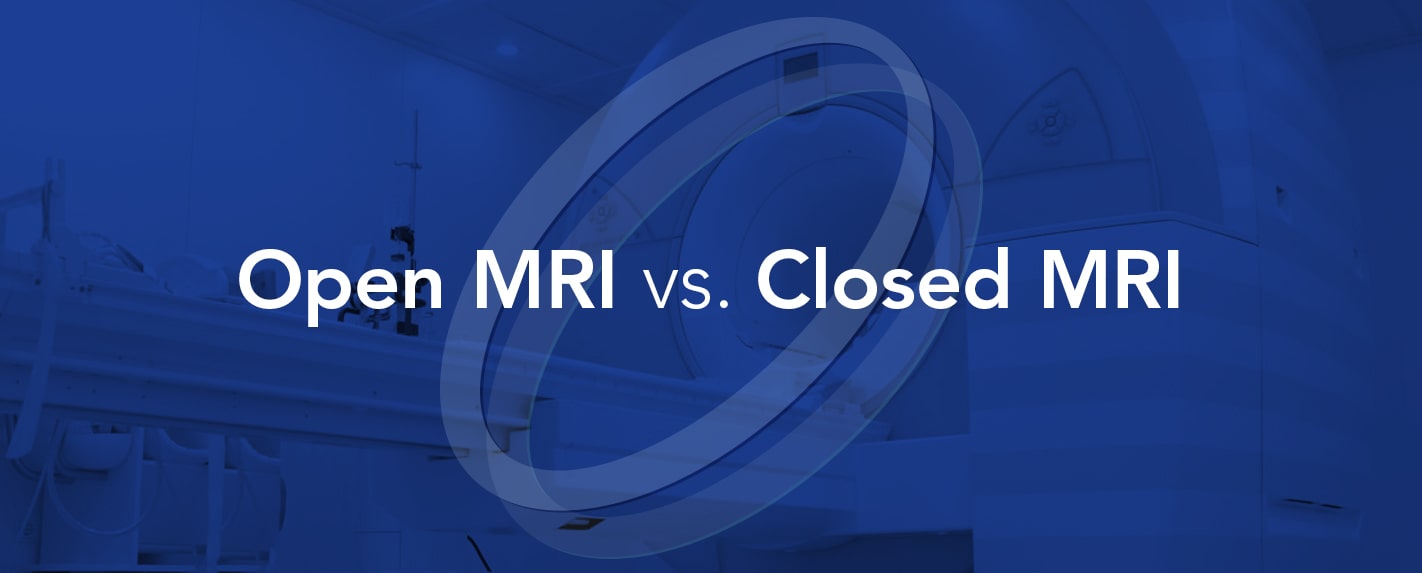
Magnetic resonance imaging (MRI) is a type of imaging test involving the use of radio waves and magnetic waves together to produce images of the body’s internal organs. Doctors use these images to analyze whether you have any abnormalities in your organs, bones, soft tissues and joints.
Jump to Sections:
- What Are MRI Machines?
- What Is a Closed MRI?
- Pros of Closed MRIs
- Cons of Closed MRIs
- What Is an Open MRI?
- Pros of Open MRIs
- Cons of Open MRIs
- Comparing Open MRI Vs. Closed MRI
- Schedule an Appointment with Health Images
What Are MRI Machines?
The MRI machine emits a predetermined strength magnetic field to perform the scan. The MRI exposes your body to magnetic waves, and the ions and particles present in your body react by emitting radio waves. The waves’ combined effect highlights your internal organs, making them more visible in greater detail for the doctor to diagnose any abnormality. The doctor views the images on a computer screen and can also print the images out through a specially designed machine for diagnosing purposes.
MRI machines, from their creation, have significantly impacted how doctors study internal organs and diagnose certain diseases. Through using MRIs, doctors can diagnose and study brain diseases more accurately, as well as ENT conditions, musculoskeletal and spinal problems, cancer and other difficult-to-diagnose conditions in their earliest stages.
When it comes to magnetic resonance imaging systems, there are two types to pick from: open MRI and closed MRI.
While the closed MRI is more common, you may consider an open MRI to accommodate you if you’re either too claustrophobic or overweight to undergo a traditional closed MRI. But, the system’s design isn’t the only difference between open vs. closed MRI. Therefore, you should learn more about both of them and evaluate the pros and cons of each carefully before you make your final decision.
Schedule an MRI at Health Images
What Is a Closed MRI?
The closed MRI has been around longer than the open MRI and features a capsule-like space you’d lie in to have high-quality images taken. The system includes a large magnet and radio wave that sends signals and receives signals to and from your body. A computer that’s attached to the scanner converts the returning signals into images. MRI scanners come in various strengths of magnetic fields measured in teslas, or “T,” typically between 0.5T and 3.0T.
The image results are highly detailed and allow doctors to come up with a correct diagnosis and tailor an individualized treatment plan for your ailment. The scan’s shape enables it to generate pictures of areas other scans don’t have available, which means closed MRIs are essential in some cases.
Pros of Closed MRIs
A closed MRI offers several advantages.
- They can help diagnose more problems than open MRIs do.
- They can offer quick scanning: Because of the magnetic field strength, they can usually scan faster, too, even if it can still take a little time to do so, depending on the body part the doctor needs scanning.
- They capture high-quality images: One significant benefit of closed MRIs is that they can capture high-quality, detailed images because of their stronger magnetic field. Although 1.5T is ideal for many imaging requirements, a 3.0T higher magnetic field helps with accurate identification of conditions such as the following:
- Fibrocartilage lesions
- Anatomic wrist structures
- Hepatic metastases
- Nerve visibility for brachial plexus patients
- Lesions in multiple sclerosis
- Multi or single-vessel conditions in CAD patients
Cons of Closed MRIs
Although the clarity of the image of a closed MRI scan is excellent, there are still disadvantages, especially where there’s a concern for your comfort. Some common cons of closed MRI systems are as follows.
- You have to remain still for the images to record clearly: While a closed MRI system could make it hard for you not to fidget, you can’t because the scans will come out blurry and you’ll need to undergo the whole process again. The disadvantages of a closed MRI lie directly in the lack of comfort they provide you. Moving inside the capsule disturbs the images. It’s crucial to stay very still, or you’ll risk having to undergo the scan again.
- You may feel claustrophobic: The shape and dimensions of the scans are tightly enclosed, which can cause some patients to feel nervous. Because it takes a few minutes to complete a full scan, it increases the claustrophobia risk, and panic attacks may develop sometimes. It’s no surprise if you experience anxiety when you must lie very still for an extended period in an enclosed space. If you’re claustrophobic, you will likely have some reservations about undergoing an MRI.
- A closed MRI system is loud: During your scan in a closed MRI, you will hear some loud banging noises. No doubt, this can become very disorienting, particularly if you have anxiety issues or are claustrophobic. The doctor can provide you with headphones and earplugs to help minimize any discomfort the loud noise causes.
- You might not fit if you are large: If you’re obese, you might not comfortably fit inside a closed MRI, or you might not fit at all. The narrow dimensions make it hard for overweight people to fit in a lot of traditional closed machines. There are wide-bore MRI systems with a larger interior space that could make it easier for you to fit inside.
What Is an Open MRI?
These machines are exactly what they sound like. They’re open, but they still use magnets for taking images of your body’s insides. Rather than being an enclosed capsule, these use a magnetic bottom and top and all four sides are open, reducing the risk of panic attacks and claustrophobia exponentially, allowing you to make use of an MRI to diagnose your condition accurately.
Pros of Open MRIs
Some advantages of open vs. closed MRI are as follows.
- They are less enclosed than a closed MRI: An open MRI system doesn’t cause the same level of claustrophobia and anxiety as a closed MRI system, since the unit doesn’t fully encase your body. The system can accommodate you much more comfortably, no matter what size you are.
- They are quieter than a closed MRI: These don’t make as much noise as a closed MRI. The sound it does make is less likely to affect you adversely, since you won’t be inside an enclosed space.
- They are more child-friendly: Most children don’t respond well to being an enclosed space by themselves. An open MRI makes it simpler to scan kids, particularly if you, the parent, are by their side.
- They enable a technologist to tilt them: Many open MRI systems come with a weight-bearing feature, allowing the technologist to tilt them and scan you in a standing position, instead of having you lie flat. This tilting feature makes it simpler to diagnose certain diseases and conditions like spinal injuries and back pain with greater accuracy.
- They promote equity: If you are physically disabled or are in a wheelchair, you could feel further isolated when you can’t use a closed machine appropriately. However, an open machine makes the transportation process more comfortable and smoother for you.
- They’re more advanced: With the evolution in medical technology over time, open MRI systems have become more advanced and more popular than their closed counterparts. Open MRI systems help doctors stay on top of the latest advancements in the medical industry.
- They cause fewer side effects: Because closed imaging scans can cause anxiety, you may require medication to control your claustrophobia, anxiety or restlessness. These drugs can come with side effects. An open MRI helps with this issue immensely, causing you to experience fewer problems to have to deal with, like medicine and recovery rate.
- They produce fewer artifacts: If you have any metallic objects in your body from a previous surgery, the artifacts from your metal implants could significantly minimize the quality of your MRI images. But, the open MRI system uses a lower magnetic field strength, which produces fewer artifacts from metallic objects than the closed MRI system’s higher magnetic field. So, you obtain a clearer image from an open MRI scan if you have metallic implants.
- They can offer cost advantages: The open MRI system costs less than a closed MRI system in terms of ongoing maintenance costs and upfront costs, typically because the open MRI system uses a cryogen-free design and has permanent magnets. There is less engineering manpower required for installation and service. But, since it has a reduced magnetic field, it might not be able to diagnose certain problems.
Cons of Open MRIs
While the open MRI tends to provide you with a much more comfortable experience, it still has some drawbacks. Some disadvantages of an open MRI vs. closed MRI are as follows.
- Open vs. closed MRI image quality varies: Open MRI systems produce lower-resolution scanning. The open MRI system’s magnets aren’t as strong as the closed MRI systems. Most low-field magnets like those used in open MRI systems use less than 0.5T, meaning the open MRI system will have more of a challenge telling fat and water apart during your scan, which results in lower-resolution images when there are smaller body parts involved.
- They are not ideal for all bodies: Because of the open MRI’s shape, it can’t take images of specific body areas and the images are of lower quality, since the open machine isn’t as strong as the closed. An open MRI isn’t always ideal. Doctors have to use a closed machine to take certain images.
- They take longer to scan images: Closed MRIs produce faster scanning of images because they surround you with higher-powered magnets on all sides. Since the open MRI system only uses magnets above and below you and not on all sides, it takes longer for the technologist to scan the targeted area, meaning it doesn’t produce full images.
- They can offer wider diagnosing options: When comparing an open vs. closed MRI machine, you’ll find a closed MRI system is more effective at diagnosing a larger range of problems because of the higher-quality images it produces due to its stronger magnetic field. But, an open MRI system accommodates you better, particularly if you are claustrophobic or have a larger body type.
Comparing Open MRI Vs. Closed MRI
Overall, you should realize the importance of MRI imaging and how it provides doctors with a unique view of your body’s insides. It’s a vital tool of today’s modern medical imaging and in diagnosing disease. Often, an MRI provides essential diagnostic information doctors can’t obtain with other types of imaging studies, and in many cases, it can result in early detection and quicker treatment of your condition.
It’s often contentious to compare closed and open MRI systems, since categorically stating one system is better than the other depends on various factors. Even so, MRI technology is constantly evolving. Each year, open MRI systems offer higher “T” strength, and closed MRI systems now feature increased patient-comfort adaptations.
The most accurate MRI system is the closed MRI scan. You lie in a tube-like, narrow space structure for the scan. Patients often report feelings of claustrophobia while being scanned in a traditional closed MRI. Being obese can make it almost impossible to undergo a closed scan. If this is the case, an open MRI might be a better option.
Some individuals who have claustrophobia can remain still for 15 minutes in a closed MRI. Fortunately, your doctor or MRI technologist may be able to help you overcome your anxiety and help you avoid fidgeting.
There are ways to relieve your anxiety when you’re undergoing an MRI test, whether you’re having a closed or open MRI:
- Ask the doctor for anti-anxiety medication or a sedative you can take during your scan, which could help alleviate fear and claustrophobia tremendously.
- Examine the MRI scanner before your appointment.
- Request earplugs if the machine is loud.
- Wear comfortable clothing.
- Try relaxation techniques during your scan. Count to 10 as you breathe slowly in through your nose and slowly exhale out your mouth. Wait a few minutes and then repeat.
- Ask a relative or friend to come with you for support. They can also drive you home if you took a sedative.
Schedule an Appointment with Health Images
At Health Images, we have multiple convenient locations in Colorado, including those in Boulder, Denver, Longmont and Castle Rock. We have a specialized team of staff members ready to help you with all your medical imaging needs without you having to commute to receive services.
Health Images revolutionizes medical imaging while maintaining a foundation of consistency and efficiency. We promise our patients spectacular service and unmistakable quality, and we pair those with cutting-edge, innovative technology and a commitment to exceptional patient care.
We are locally and privately owned and have hand-selected our staff members with purpose, so you only receive care from highly qualified and professional staff members. Because we’re proactive in the advancement of technology, you’ll always receive the most comprehensive, modern services in the Denver area.
We have a mission to pay close attention to your individual needs and provide you with only top-quality service. From your imaging provider to the technology, we’ve revolutionized the whole diagnostic imaging experience.
Our imaging centers merge this quality of service with a dedicated attentiveness to your individual needs, making us your premier medical imaging destination.
Contact us today to schedule your appointment with Health Images for your medical imaging needs.
Sources:
- https://blog.healthcare.oxinst.com/open-vs-closed-mri-systems-pros-and-cons-of-each/
- https://www.independentimaging.com/open-mri-vs-closed-mri-difference-one-best-suited/
- https://blog.healthcare.oxinst.com/open-vs-closed-mri-systems-pros-and-cons-of-each/
- https://www.independentimaging.com/open-mri-vs-closed-mri-difference-one-best-suited/
- https://www.providianmedical.com/blog/benefits-open-mri-vs-closed
- https://longevity.media/what-is-closed-mri-and-its-benefits-1
- https://a1mri.com/benefits-of-an-open-mri/
- http://mriscancenter.com/2017/07/differences-between-an-open-and-closed-mri/
- https://www.clovisopenmri.com/blog/d8nd7c6fe9lc7zex3tf8bgxzgebxjs
- https://middletownimaging.com/additional-resources/open-mri-versus-closed-mri/
- https://medimageexpress.com/uncategorized/4-benefits-open-mri/
- http://fourseasonsimaging.com/benefits-of-closed-mri-scanners/
- https://www.sumamri.com/top-3-benefits-of-an-open-mri/
- https://info.blockimaging.com/3-benefits-of-open-mri-scanners
- https://www.healthimages.com/services/mri-scans/
- https://www.healthimages.com/your-experience/what-to-expect/
- https://www.healthimages.com/locations/

